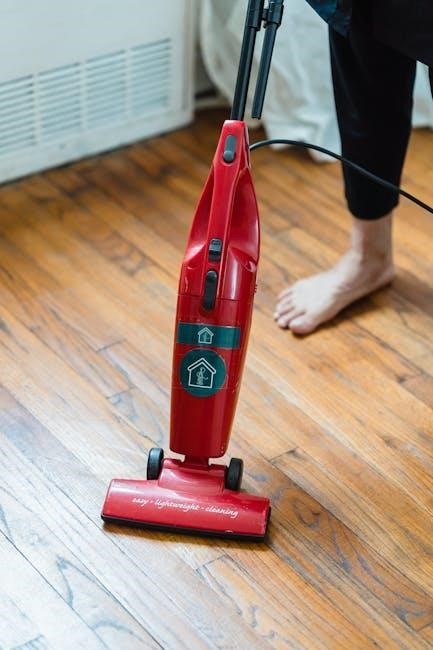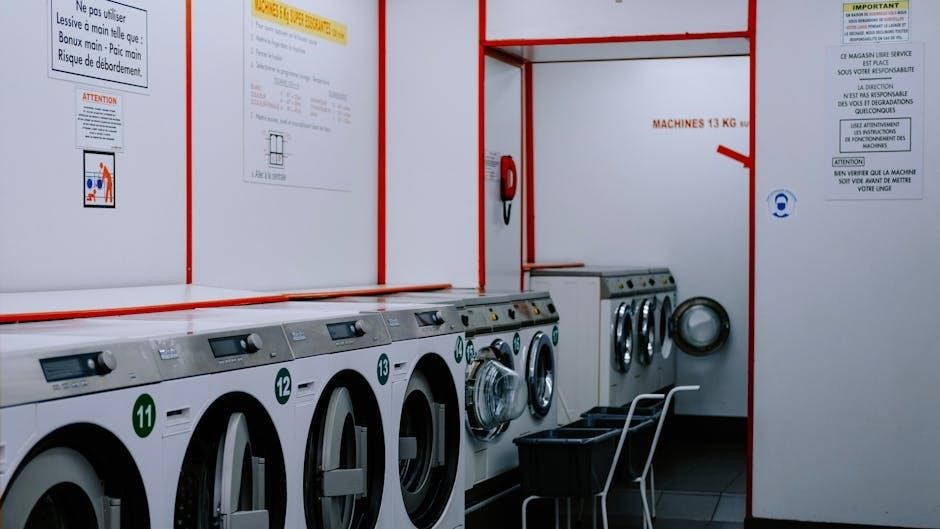GE Self-Cleaning Ovens offer a convenient and efficient way to maintain your appliance by using high-temperature cleaning cycles to eliminate food residue‚ simplifying oven maintenance and reducing the need for harsh chemicals.
Overview of GE Self-Cleaning Ovens
GE Self-Cleaning Ovens are designed to simplify oven maintenance by utilizing advanced cleaning technologies. These ovens are equipped with features like high-temperature cleaning cycles‚ steam cleaning options‚ and durable interior finishes. They are built to handle tough food residue efficiently‚ reducing the need for scrubbing and harsh chemicals. GE ovens are known for their reliability‚ energy efficiency‚ and user-friendly interfaces. The self-cleaning function works by heating the oven to extremely high temperatures‚ turning food debris into ash that can be easily wiped away. Additionally‚ these ovens often include safety features like automatic door locking and ventilation systems to ensure safe operation during the cleaning cycle. With models ranging from basic to advanced‚ GE Self-Cleaning Ovens cater to various cooking needs while providing a hassle-free cleaning experience. Regular use of these ovens helps maintain their performance and longevity.
Benefits of Using a Self-Cleaning Oven
Using a GE Self-Cleaning Oven offers numerous benefits‚ including significant time savings and reduced effort compared to manual cleaning; The high-temperature cleaning cycle effectively breaks down tough food residue into ash‚ which can be easily wiped away‚ eliminating the need for harsh chemicals. This feature also extends the lifespan of the oven by preventing food buildup that could damage the interior over time. Additionally‚ self-cleaning ovens enhance safety by automatically locking the door during the cycle‚ preventing accidental burns. They also improve cooking performance by maintaining a clean oven interior‚ which ensures consistent results. Furthermore‚ the energy-efficient design and advanced cleaning technologies reduce the environmental impact. Overall‚ a self-cleaning oven provides a convenient‚ efficient‚ and long-lasting solution for maintaining your appliance while enhancing your cooking experience.
Key Features of GE Self-Cleaning Ovens
GE Self-Cleaning Ovens are equipped with advanced features designed for effortless maintenance and optimal performance. One of the standout features is the high-temperature cleaning cycle‚ which reaches up to 880 degrees Fahrenheit to decompose food residue into ash‚ simplifying cleanup. Additionally‚ these ovens often include a steam cleaning option for lighter messes‚ allowing for quicker and gentler cleaning without extreme heat. Many models feature an automatic door locking system‚ ensuring safety by preventing the door from being opened during the cleaning cycle. Some ovens also come with programmable controls‚ enabling users to customize cleaning time based on soil levels. Furthermore‚ energy-efficient designs and durable construction ensure long-lasting reliability. These features collectively make GE Self-Cleaning Ovens a practical and efficient choice for modern kitchens.

Preparation for Self-Cleaning Cycle
Before initiating the self-cleaning cycle‚ remove all racks‚ trays‚ and food debris from the oven. Ensure the oven is empty and wipe away any loose food particles for optimal results.
Clearing the Oven
Clearing the oven is the first step in preparing for the self-cleaning cycle. Remove all racks‚ trays‚ and any cookware from the oven cavity to ensure proper cleaning. Wipe away any loose food particles or debris from the oven walls and floor using a damp cloth. Large food chunks should be scraped off and disposed of to prevent excessive smoke during the high-temperature cycle. Ensure no aluminum foil or oven liners remain inside‚ as these can interfere with the cleaning process. Additionally‚ check for any food residue on the oven door and gasket‚ as these areas can be cleaned manually before starting the cycle. A clean oven cavity ensures the self-cleaning feature works efficiently‚ leaving behind only ash that can be easily wiped away after the cycle completes.
Removing Oven Racks and Accessories
Removing oven racks and accessories is essential before initiating the self-cleaning cycle to prevent damage and ensure thorough cleaning. Start by allowing the oven and racks to cool completely to avoid burns. Gently pull the racks out and place them on a heat-resistant surface or in the dishwasher for separate cleaning. Remove any trays‚ rotisserie accessories‚ or oven liners‚ as these can interfere with the high-temperature cycle. For models with special features‚ such as steam cleaning‚ ensure all additional components are taken out. Cleaning racks separately prevents food residue from hardening further. Check your GE oven manual for specific instructions‚ as some models may require certain racks to remain inside during cleaning. Proper removal ensures the self-cleaning process is effective and avoids potential damage to the oven or its components.
Locking the Oven Door
Locking the oven door is a critical step in the self-cleaning process to ensure safety and efficiency. For most GE models‚ the door will automatically lock once the self-cleaning cycle is activated. You may hear a clicking sound as the mechanism engages. If your model requires manual locking‚ locate the latch release button and slide it into the locked position. Ensure the door is securely closed before starting the cycle. Never attempt to open the oven door during the self-cleaning process‚ as it will remain locked until the oven cools down. This safety feature prevents burns and ensures the high-temperature cleaning is effective. Always verify that the door is properly latched to avoid any issues during the cycle. Keep the kitchen well-ventilated during this time to minimize exposure to fumes.
Ensuring Proper Ventilation
Ensuring proper ventilation is essential during the self-cleaning cycle of your GE electric self-cleaning oven. Open windows and turn on exhaust fans to remove fumes and odors generated by the high-temperature cleaning process. The oven produces intense heat‚ which can release carbon monoxide and strong fumes from decomposing food residue. Adequate ventilation helps prevent these fumes from accumulating in your kitchen. For optimal airflow‚ ensure that your kitchen is well-ventilated before and during the cleaning cycle. If your oven is equipped with a range hood or vent‚ operate it on the highest setting to maximize air circulation. Avoid creating an airtight environment‚ as this can trap harmful fumes. Always follow the safety guidelines provided in your GE oven’s user manual to ensure a safe and effective cleaning experience. Proper ventilation not only enhances safety but also helps maintain indoor air quality during the self-cleaning process.

Operating the Self-Cleaning Cycle
Activate the self-cleaning feature by pressing the Clean button on your GE oven’s control panel. Select the desired cleaning time or soil level based on the residue inside; Start the cycle and let the oven heat to a high temperature to burn off food residue‚ ensuring proper ventilation to remove fumes. Once complete‚ allow the oven to cool before wiping away ash with a damp cloth for a clean finish.
Activating the Self-Clean Feature

To activate the self-clean feature on your GE electric oven‚ start by ensuring the oven is empty and all racks have been removed. Close and lock the oven door securely. Locate the Clean button on the control panel and press it. The oven will display the default cleaning time‚ typically between 2 to 4 hours‚ depending on the soil level. Use the + or — buttons to adjust the cleaning time if needed. Once your preferred settings are selected‚ press the Start button to begin the cycle. The oven will heat to a high temperature‚ usually around 880°F‚ to burn off food residue‚ turning it into ash. Ensure proper ventilation in your kitchen during this process to prevent fumes from building up. The oven door will remain locked until the cycle is complete and the oven has cooled down slightly.
Selecting the Cleaning Time or Soil Level
Selecting the appropriate cleaning time or soil level is crucial for effective self-cleaning. GE ovens typically offer preset cleaning times‚ ranging from 2 to 4 hours‚ depending on the severity of the soil. The default cleaning time is usually 3 hours‚ but you can adjust it using the control panel. For lighter messes‚ a shorter cycle may suffice‚ while heavily soiled ovens require the maximum time. Some models allow selecting low‚ medium‚ or high soil levels‚ which automatically set the cleaning duration. Ensure you choose the correct setting based on the oven’s condition to optimize cleaning efficiency. Once selected‚ press Start to begin the cycle. Always refer to your specific oven model’s manual for precise instructions‚ as settings may vary slightly between models. Proper selection ensures thorough cleaning without unnecessary energy use.
Starting the Cleaning Cycle
Once the oven is prepared and the cleaning time or soil level is selected‚ press the Start button to begin the self-cleaning cycle. The oven door will automatically lock‚ and the display will show the selected duration. The oven will heat to a high temperature‚ reaching up to 880°F (471°C)‚ to burn food residue into ash. During the cycle‚ you may hear ticking or clicking noises due to thermal expansion. The cleaning process typically lasts between 2 to 4 hours‚ depending on the soil level. After the cycle completes‚ the oven will cool down‚ and the door will unlock. Ensure the oven has cooled sufficiently before opening the door or wiping away ash. Always follow the specific instructions for your GE oven model to ensure safe and effective cleaning. Proper initiation of the cycle is key to achieving a clean oven with minimal effort.
Understanding the High-Temperature Cleaning Process
The high-temperature cleaning process in GE Self-Cleaning Ovens uses intense heat‚ reaching up to 880°F (471°C)‚ to break down food residue into ash. This process is efficient and reduces the need for manual scrubbing. The oven door locks automatically to ensure safety during the cycle‚ which typically lasts 2 to 4 hours‚ depending on the soil level. Proper ventilation is essential to prevent fumes from spreading in the kitchen. After the cycle‚ the oven cools down‚ and the ash can be easily wiped away. This method is both time-saving and effective‚ maintaining the oven’s cleanliness without harsh chemicals. Always allow the oven to cool completely before cleaning to avoid burns or damage. The high-temperature process is a key feature that makes GE Self-Cleaning Ovens a practical choice for homeowners.

Safety Instructions for Self-Cleaning Ovens
Ensure proper ventilation to minimize fumes and avoid inhaling harmful gases. Never use abrasive cleaners or harsh chemicals. Keep children away during the cycle. Always lock the oven door securely before starting the cleaning process. Avoid opening the door while the oven is in use‚ as it may cause burns. If you notice unusual odors or smoke‚ turn off the oven and ventilate the area. Refer to your GE oven’s user manual for specific safety guidelines. Always follow the recommended cleaning times and temperatures to prevent damage. After the cycle‚ allow the oven to cool completely before wiping away ash. Never leave the kitchen unattended during the self-cleaning process. If you have pets‚ ensure they are kept away from the oven during cleaning. Proper ventilation is crucial to prevent carbon monoxide buildup. Open windows or use a ventilation fan or hood to maintain airflow. Be cautious of the intense heat emitted during the cycle‚ as it can cause burns. Keep a fire extinguisher nearby as a precaution. If you experience any issues during the cleaning process‚ turn off the oven and contact GE customer support immediately. Always prioritise safety to avoid accidents and ensure efficient cleaning.
General Safety Precautions
When using a GE self-cleaning oven‚ always ensure proper ventilation to avoid inhaling harmful fumes. Open windows or use a ventilation fan to maintain airflow. Never use abrasive cleaners or harsh chemicals‚ as they can damage the oven’s surfaces or release toxic fumes during high-temperature cleaning. Keep children and pets away from the oven during the cleaning cycle‚ as the exterior may become extremely hot. Avoid opening the oven door during the cycle‚ as intense heat can cause burns. Lock the oven door securely before starting the cycle to prevent accidental opening. If unusual odors or smoke appear‚ turn off the oven and ventilate the area immediately. Always follow the recommended cleaning times and temperatures to avoid damage. After the cycle‚ allow the oven to cool completely before wiping away ash. Never leave the kitchen unattended during the self-cleaning process. If you experience any issues‚ turn off the oven and contact GE customer support for assistance.

Handling Fumes and Ventilation
Proper ventilation is crucial when using the self-cleaning feature on your GE electric oven. Open windows and ensure good airflow in your kitchen to prevent the buildup of harmful fumes. Use an exhaust fan to circulate air and reduce odors. The high-temperature cleaning process may release fumes‚ including carbon monoxide‚ so ventilation is essential to avoid exposure. Avoid inhaling these fumes directly‚ as they can cause discomfort or health issues. If you notice strong smells or smoke‚ turn off the oven and improve ventilation immediately. Never rely solely on air conditioning or closed vents‚ as this can trap fumes indoors. Always prioritize ventilation to ensure a safe and effective cleaning process. Proper airflow helps minimize odors and ensures the cycle runs smoothly.
Avoiding Hazards During the Cleaning Cycle
During the self-cleaning cycle‚ it’s essential to take precautions to avoid potential hazards. The oven reaches extremely high temperatures‚ up to 880°F‚ which can cause severe burns if the oven or surrounding surfaces are touched. Never open the oven door during the cycle‚ as hot fumes and intense heat can escape. Keep children and pets away from the oven while it’s cleaning. Additionally‚ avoid using abrasive cleaners or scrubbers immediately after the cycle‚ as the oven surfaces may still be hot. Always ensure proper ventilation to prevent the buildup of fumes‚ including carbon monoxide. If you notice excessive smoke or odors‚ turn off the oven and improve ventilation. Never leave the kitchen unattended during the cleaning process. By following these safety guidelines‚ you can minimize risks and ensure a safe and effective cleaning experience.
Post-Cycle Safety Measures
After the self-cleaning cycle completes‚ allow the oven to cool down completely‚ which may take 30 to 90 minutes. Never touch the oven surfaces or door immediately‚ as they remain extremely hot. Use oven mitts or tongs to handle any racks or accessories. When wiping away ash‚ use a damp cloth or paper towel to prevent ash from becoming airborne. Avoid using abrasive cleaners or scrubbers on hot surfaces‚ as this could damage the oven’s finish. Ensure the kitchen is well-ventilated to clear any lingering fumes. Keep children and pets away until the oven has cooled. Always refer to your GE oven’s user manual for model-specific post-cycle safety recommendations to ensure safe and effective cleaning results.

Maintenance and Care
Regularly wipe the oven door and exterior with a damp cloth. Clean racks and accessories separately. For minor spills‚ use steam cleaning. Avoid harsh chemicals for lasting performance. Refer to the manual for specific care instructions.

Cleaning the Oven Door and Exterior
Cleaning the oven door and exterior is essential for maintaining the appearance and functionality of your GE self-cleaning oven. For the exterior‚ use a damp cloth to wipe down surfaces‚ removing any splatters or spills. Avoid using abrasive cleaners or scrubbers‚ as they may damage the finish. For tougher stains‚ mix a solution of mild soap and water‚ applying it with a soft sponge. Never use harsh chemicals or bleach‚ as they can harm the oven’s surfaces.
The oven door can be cleaned while it’s cool. Remove any large food particles with a paper towel‚ then wipe it down with a damp cloth. For glass panels‚ use a glass cleaner and a lint-free cloth to avoid streaks. Regular cleaning prevents grime buildup and keeps the door sealing properly for optimal performance. Always refer to your user manual for specific cleaning recommendations tailored to your model.
Maintaining Oven Racks and Accessories
To maintain your GE self-cleaning oven’s racks and accessories‚ remove them before starting the cleaning cycle. Wash racks and utensils by hand with mild soap and warm water‚ or place them in the dishwasher for convenience. Avoid using abrasive cleaners or scrubbers‚ as they may damage the finishes. For tough stains‚ soak the racks in a mixture of hot water and baking soda before scrubbing gently.
After cleaning‚ dry the racks thoroughly to prevent water spots. When reinstalling‚ ensure they are securely placed to avoid shifting during cooking. Regularly cleaning and maintaining these components prevents food residue from building up and ensures optimal performance. Always refer to your user manual for specific care instructions tailored to your oven model and accessories.

Troubleshooting Common Issues
Troubleshooting common issues with your GE self-cleaning oven may involve checking for error codes‚ ensuring proper ventilation‚ or addressing incomplete cleaning cycles. Refer to your user manual for specific solutions or contact GE customer support if problems persist.
Issues with the Self-Clean Feature
Issues with the self-clean feature on your GE electric oven can stem from improper preparation‚ such as not removing racks or accessories‚ or failure to lock the oven door securely. Additionally‚ incorrect settings‚ like selecting the wrong cleaning time or soil level‚ may result in incomplete cleaning cycles. Some users have reported error codes or the self-clean feature not activating‚ which could be due to malfunctioning sensors or control panels; Ensure the oven is empty and all food debris is wiped away before starting the cycle. If problems persist‚ consult the user manual or contact GE customer support for assistance. Proper ventilation is also crucial to prevent fumes from causing discomfort. Always follow the recommended guidelines to avoid operational issues and ensure safe‚ effective cleaning.
Dealing with Residual Ash and Stains
After the self-cleaning cycle‚ some residual ash and stains may remain in your GE electric oven. Allow the oven to cool completely before addressing these remnants. Use a damp cloth or sponge to wipe away the ash‚ as it can be easily swept out. For tougher stains‚ mix baking soda and water to create a paste‚ apply it to the affected areas‚ and let it sit before scrubbing gently. Avoid using abrasive cleaners or scrubbers to prevent damaging the oven’s interior. Regularly cleaning minor spills and food residue can help reduce the need for frequent self-cleaning cycles. Always ensure the oven is cool and well-ventilated when handling ash and stains to maintain a safe and efficient cleaning process.

Additional Cleaning Options
GE self-cleaning ovens offer steam cleaning for minor spills and manual cleaning for tough stains‚ providing versatile solutions for maintaining your oven’s cleanliness and performance.
Steam Cleaning for Minor Spills
For minor spills and light messes‚ GE self-cleaning ovens offer a steam cleaning option. This feature uses water to create steam‚ loosening food residue without extreme heat. To use steam cleaning‚ pour one cup of water into the oven bottom‚ close the door‚ and select the steam function. The cycle typically runs for 30 minutes‚ making it a quick and energy-efficient solution. This method is ideal for maintaining cleanliness between deep cleans. Always ensure the oven is cool before adding water and avoid using abrasive cleaners. Steam cleaning is a gentle yet effective way to keep your oven clean without the long wait of a full self-cleaning cycle. It’s perfect for everyday maintenance and minor food spills‚ ensuring your oven remains in great condition.
Manual Cleaning for Tough Stains
For tough stains that the self-cleaning cycle doesn’t fully remove‚ manual cleaning may be necessary. Turn off the oven and allow it to cool completely before starting. Avoid using harsh chemicals or abrasive cleaners‚ as they can damage the oven’s finish. Instead‚ mix baking soda and water to form a paste‚ applying it directly to the stained areas. Let it sit overnight‚ then wipe clean with a damp cloth. For particularly stubborn stains‚ a gentle scrubber may be used‚ but avoid metal scourers to prevent scratching. After cleaning‚ rinse thoroughly and dry the surfaces to maintain their appearance. Always refer to your GE oven’s manual for approved cleaning products and methods to ensure longevity and safety. Regular manual touch-ups can help maintain a pristine oven interior between self-cleaning cycles.
Where to Find the User Manual
Your GE Self-Cleaning Oven’s user manual is typically included with the appliance at the time of purchase; If you’ve misplaced it‚ you can easily access a digital version on the official GE Appliances website. Visit www.geappliances.com‚ navigate to the “Support” section‚ and enter your oven’s model number to download the manual. Additionally‚ customer support can assist you in retrieving a copy if needed. The manual provides detailed instructions for operating‚ cleaning‚ and maintaining your oven‚ ensuring you get the most out of its features. Always refer to the manual for specific guidance tailored to your model‚ as instructions may vary slightly between different GE oven designs. For further assistance‚ contact GE Appliances directly through their official website or support hotline.
Contacting GE Customer Support
For any questions or issues regarding your GE Self-Cleaning Oven‚ contact GE Appliances customer support directly. You can reach them by visiting their official website at www;geappliances.com and navigating to the “Support” section. From there‚ you can access live chat‚ FAQs‚ or contact information. Additionally‚ you can call their customer service hotline at 1-800-626-2002 for personalized assistance; Representatives are available to help with troubleshooting‚ repair requests‚ or clarifying instructions for using the self-cleaning feature. If you’re unable to find your user manual‚ support agents can also guide you on how to download a digital copy. GE Appliances is committed to ensuring a seamless experience for their customers‚ providing reliable support for all your oven-related needs.
GE Self-Cleaning Ovens simplify maintenance with high-temperature cycles‚ reducing manual effort. Proper preparation‚ ventilation‚ and post-cycle care ensure optimal performance and longevity‚ making maintenance straightforward and effective for home use.
Final Tips for Effective Oven Cleaning
For optimal results‚ always clear the oven of racks and debris before starting the self-clean cycle. Ensure proper ventilation by opening windows or using a vent hood to minimize fumes. Avoid using abrasive cleaners on the exterior or door seals‚ as they may damage the finish. After the cycle‚ allow the oven to cool before wiping away ash with a damp cloth. Regular steam cleaning can help maintain the oven’s condition between deep cleans. Never leave the oven unattended during the self-clean cycle‚ and keep children away for safety. By following these tips‚ you can keep your GE self-cleaning oven in excellent condition and ensure efficient‚ hassle-free cleaning.
Long-Term Maintenance for Optimal Performance
Regular maintenance ensures your GE self-cleaning oven performs efficiently over time. After each use‚ wipe down surfaces to prevent food buildup. Schedule self-clean cycles every 1-3 months‚ depending on usage. Avoid using harsh chemicals‚ as they can damage the oven’s interior. Clean the oven door glass with a gentle detergent to maintain clarity. Check and replace worn-out door seals to retain heat during cooking and cleaning cycles. Ensure proper ventilation after each cycle to prevent moisture buildup. For tougher stains‚ consider manual cleaning with approved products. Refer to your user manual for model-specific care instructions. By adhering to these practices‚ you can extend the lifespan of your oven and maintain its self-cleaning functionality. Consistent upkeep will also enhance cooking performance and energy efficiency‚ ensuring your appliance remains reliable for years.


